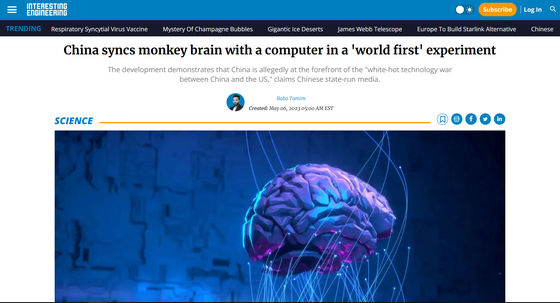A Chinese scientist team announced that they succeeded in an experiment to connect a monkey's brain and a computer to move a robot arm

Chinese state media reported on the night of May 5, 2023 that a neurosurgery team at Xuanwu Hospital of
Successfully passed the international non-human long-term animal intervention type computer interface test, our country's computer interface technology has been broken again! _Beijing Daily Network
https://news.bjd.com.cn//2023/05/06/10421575.shtml

China completes the world's first interventional BCI experiment on non-human primates - Chinadaily.com.cn
https://www.chinadaily.com.cn/a/202305/06/WS6455aaaaa310b6054fad160c.html

China syncs monkey brain with a computer in a 'world first' experiment
https://interestingengineering.com/science/china-syncs-monkey-brain-with-a-computer

BCI makes computers operable by reading brain activity with special chips and machines. In recent years, research on BCI has been actively promoted, and in particular, the startup 'Neuralink' launched by Mr. Elon Musk aims to 'merge the human brain and AI', and monkeys with chips already embedded in the brain are only thinking. We have released a video of operating the game.
A video of a monkey with a chip embedded in the brain playing a game with only ``thinking'' will be released-GIGAZINE

There are three main types of BCI technology: invasive BCI, non-invasive BCI, and interventional BCI. Invasive BCI is a type that embeds chips and machines directly into the brain by brain surgery, and the chip that Neuralink is researching corresponds to this invasive BCI. Non-invasive BCI is a type that measures brain waves by non-invasive methods that do not involve surgery, such as attaching electrodes or attaching an external device to the head.
And what the neurosurgery team at Xuanwu Hospital of Capital Medical University presented this time is an experiment of interventional BCI. Interventional BCI involves placing an electroencephalograph, like a cardiac stent, in the brain through minimally invasive surgery, rather than opening the head and attaching it directly to the brain. Although the accuracy of electroencephalogram measurement by interventional BCI is lower than that of invasive BCI, the advantage is that there is no need to perform craniotomy, which places a heavy burden on the subject.

A neurosurgery team at Xuanwu Hospital, Capital Medical University, placed an electroencephalograph on the cerebral blood vessel wall of a monkey and reported that they succeeded in controlling a robot arm using only the monkey's thoughts. Ma Yongjie said, ``We succeeded in the world's first interventional BCI experiment on non-human primates. , There is still a long way to go,' he said, adding that the next challenge is to optimize the electrode design and verify the safety and reliability of long-term implantation in animals.

According to Interesting Engineering, an IT news site, China and the United States are competing in the technological competition of BCI, and the United States, where there are many BCI startups such as Neuralink, is far ahead of China in the field of invasive BCI. It is said that there is. The neurosurgery team at Xuanwu Hospital of Capital Medical University said the success of this experiment puts China at the forefront of interventional BCI technology.
Regarding intervention-type BCI, there is a startup in the United States that is already developing brain implants for people with disabilities, albeit at the experimental stage.
What is 'Synchron', a startup that inserts brain implants from blood vessels and allows disabled people to use cursors and devices? -GIGAZINE

Related Posts:
in Science, Posted by log1i_yk







